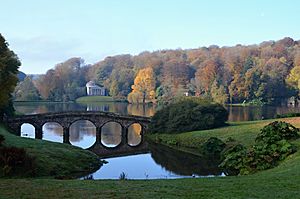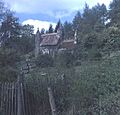Stourhead facts for kids
Quick facts for kids Stourhead |
|
|---|---|

The Palladian bridge and Pantheon
|
|
| Type | House and garden |
| Location | Stourton with Gasper, Wiltshire, England |
| Built | House: 1721–1724, destroyed in fire, rebuilt 1906 Gardens: 1741–1780 |
| Architect | Colen Campbell |
| Architectural style(s) | Neo-Palladian |
| Governing body | National Trust |
|
Listed Building – Grade I
|
|
| Official name: Stourhead House | |
| Designated | 6 January 1966 |
| Reference no. | 1131104 |
| Official name: Stourhead | |
| Designated | 1 September 1987 |
| Reference no. | 1000471 |
|
Listed Building – Grade I
|
|
| Official name: The Palladian Bridge | |
| Designated | 6 January 1966 |
| Reference no. | 1131099 |
|
Listed Building – Grade I
|
|
| Official name: The Pantheon | |
| Designated | 6 January 1966 |
| Reference no. | 1131102 |
|
Listed Building – Grade I
|
|
| Official name: The Temple of Apollo | |
| Designated | 6 January 1966 |
| Reference no. | 1131100 |
| Lua error in Module:Location_map at line 420: attempt to index field 'wikibase' (a nil value). | |
Stourhead is a huge estate in England, famous for its beautiful house and gardens. It is located where the River Stour begins, in the southwest of Wiltshire. The estate also extends into Somerset.
This amazing place covers about 2,650 acres (1,072 hectares). It includes an 18th-century Neo-Palladian mansion, the village of Stourton, and one of the most famous English landscape gardens. Stourhead has been looked after by the National Trust since 1946.
Contents
The Stourhead House
The Stourton family lived at Stourhead for 500 years. In 1717, Henry Hoare, whose father was a rich banker, bought the estate. He decided to build a brand new house.
The original manor house was taken down. A new house, designed by Colen Campbell, was built between 1721 and 1725. Over the next 200 years, the Hoare family collected many valuable items. These included a large library and a big art collection.
In 1902, a fire badly damaged the house. Luckily, many of the valuable items were saved. The house was then rebuilt to look almost exactly the same.
The last Hoare family member to own Stourhead was Sir Henry Hugh Arthur Hoare, 6th Baronet. He gave the house and gardens to the National Trust in 1946. This was one year before he passed away. His only son had died in World War I in 1917.
The house was officially recognized as a Grade I listed building in 1966. This means it is a very important historic building.
Art Collection at Stourhead
Henry Hoare's impressive art collection is on display at Stourhead. His special purchases are shown in the 'Painted Alcove' or Italian Room of the house.
Hoare's collection includes many prints that were colored by hand. They were colored so skillfully that people sometimes thought they were oil paintings. These prints are copies of works by famous Italian artists. An artist known as "Mr. Studio" is believed to have done the hand-coloring.
Other Buildings on the Estate
While Colen Campbell designed the main estate, other architects helped make Stourhead what it is today. William Benson, Henry Hoare's brother-in-law, helped build the estate in 1719.
Francis Cartwright, a skilled builder and architect, worked on Stourhead from 1749 to 1755. He was known for carving wood and stone. Nathaniel Ireson was another master builder who worked on the estate. His work here helped start his career in 1720.
Over time, new buildings and changes were added to the estate. Henry Flitcroft designed three temples and a tower. The Temple of Ceres was added in 1744. The Temple of Hercules followed in 1754, and the Temple of Apollo in 1765. That same year, Flitcroft designed Alfred's Tower, which was built in 1772.
Later, Sir Richard Colt Hoare owned Stourhead. John Carter added a pretty cottage to the grounds in 1806. Architect William Wilkins created a Greek-style lodge in 1816.
In 1840, Charles Parker made more changes to the estate. He added a portico to the main house. All these new additions were designed to match the original style of Stourhead.
Gardens and Monuments
The beautiful lake at Stourhead was created by people, not nature. Walking around the lake is meant to feel like a journey. It is inspired by the story of Aeneas's trip into the underworld from Greek mythology.
The garden's design also reflects the "spirit of the place". This idea was made popular by the poet Alexander Pope. Buildings and monuments around the lake remember family history and local events.
Henry Hoare loved art. One of his paintings, Aeneas at Delos by Claude Lorrain, is thought to have inspired the garden's look. Passages from Aeneas's journey are even quoted in the temples around the lake.
Monuments are placed to create amazing views of each other. For example, the Pantheon, designed by Flitcroft, draws visitors closer. Once you reach it, you can see beautiful views from the other side of the lake. The Pantheon was considered the most important building in the gardens. It appears in many artworks owned by Hoare that show Aeneas's travels.
The plants in the garden were arranged to create different feelings. This was meant to guide visitors through different thoughts. Henry Hoare believed that green plants should be grouped together like shades in a painting. This would create a contrast between dark and light areas.
The gardens were designed by Henry Hoare II. They were created between 1741 and 1780. The design is a classic 18th-century style, built around a large lake. This lake was made by damming a small stream.
The gardens were inspired by painters like Claude Lorrain, Poussin, and Gaspard Dughet. These artists painted ideal Italian landscapes. An early feature, built before the lake, is the Temple of Flora (1744–46). It now holds a copy of the Borghese Vase.
Other features around the lake include the five-arched Palladian Bridge. There is also the Rockwork Bridge and, to the west, the grotto and the Gothic Cottage.
On a hill overlooking the gardens stands an obelisk from 1839. There is also King Alfred's Tower, a 50-meter-tall brick folly designed by Henry Flitcroft in 1772. On another hill, the Temple of Apollo offers a great spot to see the rhododendrons, water, and other temples. The large medieval Bristol High Cross was moved here from Bristol. The gardens are also home to a huge collection of trees and shrubs from all over the world.
Sir Richard Hoare, 2nd Baronet, Henry Hoare II's grandson, inherited Stourhead in 1783. He added the library wing to the mansion. In the garden, he built the boathouse. He also removed some features that didn't fit the classical and gothic styles, like a Turkish Tent. He greatly improved the planting. The Temple of Apollo now rises from a wooded slope that was planted during his time.
The gardens were listed as Grade I on the Register of Historic Parks and Gardens in 1987. This means they are very important historically.
Typography
The National Trust has its own special font, designed by Paul Barnes. This font is based on an inscription found in the grotto at Stourhead. The original inscription was accidentally destroyed around 1960. A copy was made from old photographs.
Gallery
-
The Temple of Apollo high on a hill overlooking the gardens, based on a circular temple at Baalbec
-
Sleeping nymph statue in the Grotto
-
King Alfred's Tower c. 1770 by Henry Flitcroft
-
Bristol High Cross 1373 relocated to Stourhead 1764
See also
 In Spanish: Stourhead House para niños
In Spanish: Stourhead House para niños





























